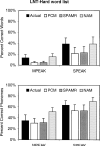Modeling spoken word recognition performance by pediatric cochlear implant users using feature identification
- PMID: 11132784
- PMCID: PMC3440002
- DOI: 10.1097/00003446-200012000-00005
Modeling spoken word recognition performance by pediatric cochlear implant users using feature identification
Abstract
Objective: Computational simulations were carried out to evaluate the appropriateness of several psycholinguistic theories of spoken word recognition for children who use cochlear implants. These models also investigate the interrelations of commonly used measures of closed-set and open-set tests of speech perception.
Design: A software simulation of phoneme recognition performance was developed that uses feature identification scores as input. Two simulations of lexical access were developed. In one, early phoneme decisions are used in a lexical search to find the best matching candidate. In the second, phoneme decisions are made only when lexical access occurs. Simulated phoneme and word identification performance was then applied to behavioral data from the Phonetically Balanced Kindergarten test and Lexical Neighborhood Test of open-set word recognition. Simulations of performance were evaluated for children with prelingual sensorineural hearing loss who use cochlear implants with the MPEAK or SPEAK coding strategies.
Results: Open-set word recognition performance can be successfully predicted using feature identification scores. In addition, we observed no qualitative differences in performance between children using MPEAK and SPEAK, suggesting that both groups of children process spoken words similarly despite differences in input. Word recognition ability was best predicted in the model in which phoneme decisions were delayed until lexical access.
Conclusions: Closed-set feature identification and open-set word recognition focus on different, but related, levels of language processing. Additional insight for clinical intervention may be achieved by collecting both types of data. The most successful model of performance is consistent with current psycholinguistic theories of spoken word recognition. Thus it appears that the cognitive process of spoken word recognition is fundamentally the same for pediatric cochlear implant users and children and adults with normal hearing.
Figures



References
-
- Black JW. Multiple-choice intelligibility tests. Journal of Speech and Hearing Disorders. 1957;22:213–235. - PubMed
-
- Boothroyd A. Auditory capacity of hearing-impaired children using hearing aids and cochlear implants: Issues of efficacy and assessment. Scandinavian Audiology Supplement. 1997;26(Suppl. 46):17–25. - PubMed
-
- Boothroyd A, Nittrouer S. Mathematical treatment of context effects in phoneme and word recognition. Journal of the Acoustical Society of America. 1988;84:101–114. - PubMed
-
- Busby PA, Dettman SJ, Altidis PM, Blamey PJ, Roberts SA. Assessment of communication skills in implanted deaf children. In: Clark GM, Tong YC, Patrick JF, editors. Cochlear prostheses. Churchill Livingstone; Edinburgh: 1990.
-
- van Dijk JE, van Olphen AF, Langereis MC, Mens LHM, Brokx JPL, Smoorenburg GF. Predictors of cochlear implant performance. Audiology. 1999;38:109–116. - PubMed
Publication types
MeSH terms
Grants and funding
LinkOut - more resources
Full Text Sources
Medical

